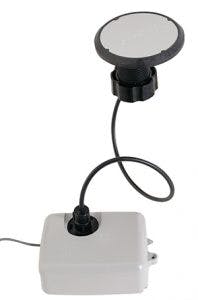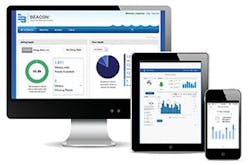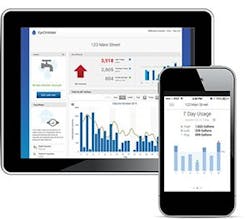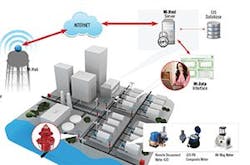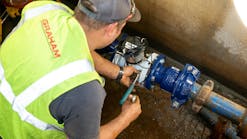Simply collecting data is the easy part. Making sense of it is more complicated, and properly using it for planning purposes is even harder. Acquiring and utilizing accurate data in a timely manner is, by far, the biggest challenge.
New technology has opened a path for water system managers to obtain water usage data in real time and apply this information immediately to ongoing water supply operations. The first of these, automatic meter reading (AMR), operates at the level of individual data collection nodes. AMR is the process of automatically collecting consumption data from meters recording usage of various utilities and transferring this data to a central system for analysis and billing. The second, advanced metering infrastructure (AMI), operates as part of the overarching system of data acquisition and analysis, allowing for two-way communication between data collection points and the system operators. AMI pulls everything together into one package as an integrated system of AMR smart meters, two-way communications networks, data analytical software, and data management systems that allows for both feedback and communication between water utilities and customers.
The operation of these systems is like any other data management system used before now that either relied on slow manual data acquisition (aka “meter reading”) or even used AMR but without the benefit of integration provided by AMI. If time is money, the speed of acquiring water use data is the most obvious advantage of such a system. But AMR/AMI does not stop at data acquisition. It really shines as a planning tool, allowing for trend analysis, troubleshooting, and projections of future trends. It is one of those technologies that make us wonder how we ever got along without it.
THE IMPORTANCE OF ACCURATE WATER USE DATA
Water data is all about achieving a balanced water budget. A water budget consists of several sources of water: precipitation, snowmelt, surface water, and groundwater. It also includes all of those consumers of water: residential consumption, industrial use, agricultural applications, power generation, evapotranspiration (the sum of evaporation from soils, surface-water bodies, and plants), percolation into the ground, runoff, and sewage. What water source a city relies on depends on its location. In arid regions (where evapotranspiration rates exceed precipitation), cities rely on importing water from other regions or deep mining what is essentially non-renewable groundwater. Such communities rely on massive damming projects or continuous depletion of groundwater with ever lowering groundwater tables. In wet regions (where annual precipitation exceeds evapotranspiration) surface water bodies (both natural lakes and rivers or man-made reservoirs) located within the local runoff basin are the primary sources of water. The result is a complex network of water supply systems along with legal and political claims involving water rights.
To avoid conflicts over water, wastage, or misapplication of water resources, each region and community requires a coordinated water budget. The US Geological Survey explains, “Water budgets are tools that water users and managers use to quantify the hydrologic cycle. A water budget is an accounting of the rates of water movement and the change in water storage in all or parts of the atmosphere, land surface, and subsurface. Although simple in concept, water budgets may be difficult to accurately determine. It is important for the public and decision makers to have an appreciation of the uncertainties that exist in water budgets and the relative importance of those uncertainties in evaluating how much water may be available for human and environmental needs.” (Source: US Geological Survey, “Water Budgets: Foundations for Effective Water-Resources and Environmental Management,” USGS Circular 1308, 2007).
The key words here are “difficult to accurately determine.” In part, that is due to the vagaries of the hydrologic cycle, the circulation of water from the ocean to the atmosphere to land surface and underground aquifer. The water budget, as determined by the water budget calculation, takes into account the hydrologic cycle of the local region or watershed as well as the effects of human consumption of local water sources. This equation is expressed as follows:
P + Qi = ET + ∆S + Qo
Where,
P = precipitation
Qi = water flow into the watershed
ET = evapotranspiration
∆S = change in water storage
Qo = water flow out of the watershed
(Source: US Geological Survey, “Water Budgets: Foundations for Effective Water-Resources and Environmental Management,” USGS Circular 1308, 2007.)
Water budget equation units can be in terms of volumes (for a fixed time interval), fluxes defining volume per time (cubic meters per day or acre-feet per year, e.g.), and flux densities expressing volume per unit area of land surface per time (millimeters per day, e.g.).
Qi is typically a man-made amount, the result of inflows from aqueducts and canals carrying water into a watershed from an outside source. Qo is equal to uncaptured runoff that escapes a watershed through its discharge point (river, stream, or another outfall). Precipitation includes all direct rainfall and snowmelt as well as the artificial precipitation of applied irrigation. Evapotranspiration is primarily losses to the atmosphere from exposed bodies of water, but also includes water taken up by woodlands, crops, and other vegetation. In some arid regions, surface water runoff can evaporate before it can flow out of the watershed.
Changes in water storage (ignoring changes in cloud cover, which contains minimal amounts of water) occur either in surface bodies of water or in subsurface aquifers. In both cases, these storage media can be indirectly fed by surface runoff and percolation into the ground or directly fed by rivers and streams and groundwater flows. And while storage units can then discharge accumulated water by means of exiting river flows and groundwater movement, the key factor in altering storage rates is human activity and water demand. So, to make the water budget work, it needs accurately and completely defined boundaries between storage units, watersheds, and groundwater-bearing strata.
It also requires good data. A water budget depends heavily on good data if it is going to be an effective planning tool. Never has the phrase “garbage in, garbage out” been more applicable. But good data is invaluable to both long-range planning and daily operations. With good data, water system planners and operators can evaluate both geographical and seasonal patterns in water and groundwater use, acute spikes in water use, along with long-term chronic stress on water storage and water supply. In essence, a water budget is no different than any other budget, only the currency happens to be gallons of water instead of dollars and cents.
Like a well-maintained checkbook, a water budget can show where water is going and why, as well as water income and whether an existing or projected shortfall exists. Accuracy of data for planning purposes is time-dependent, with the most useful and accurate water use data being accumulated in near-real time. In the context of a “smart city” (more on this below), this income and outgo of data is both continuous and continuously updated and refined.
So why is the smart city concept not being applied more often to water use management? First, the “smart city” is a relatively new concept. Yes, it can be used as something of a buzzword, but the concepts behind it are very real, practical, and valuable. Still, new ideas need time for widespread adoption. There is also a planning bias in favor of big, new projects instead of incrementally improving and maximizing the efficiency of existing assets. This is ironic because the effectiveness and efficiency of a new water supply project will always be in question if its implementation is based on incomplete or faulty data.
Planners also need to know the difference between accuracy and precision, as this relates to the data they are gathering. Accuracy refers to the closeness of a measured value to a standard or known value. For example, if a meter records water usage at a commercial customer as 100 gallons for a given work day, but the actual usage rate is 500 gallons per day, the data is not very accurate. Precision, on the other hand, refers to the closeness of two or more measurements to each other. For example, if daily meter readings give a value of 100 gallons for each of five successive workdays, then the data is very precise. But precision has nothing to do with accuracy. As in this case, the data can be very precise but inaccurate. It is also possible to be accurate but imprecise. Of the two, accuracy is what is important for water use modeling and water system planning. AMR/AMI technology makes high degrees of accuracy possible.
Neptune’s Mach10 meter
AUTOMATIC METER READING TECHNOLOGY VERSUS ADVANCED METERING INFRASTRUCTURE
AMR is defined as a “system where aggregated kWh [kilowatt-hour] usage, and in some cases demand, is retrieved via an automatic means such as a drive-by vehicle or walk-by handheld system.” In other words, automated meter reading is a technology used for collecting data from utility meters. This data consists of water usage over a particular billing period and is used for billing purposes. It translates the mechanical data from a water meter into a digital signal whose information can be sent directly to the water supplier. Therefore, the data can be acquired without the need of physical access or visual inspection by a water system employee. AMR data transmittal can be performed by handheld, mobile, and network technologies utilizing both wireless and wired telephony platforms, radio frequency (RF) broadcast signals, or even by communication along a power line transmission. Data transmission can be performed by telephone, power line, satellite, cable, Wi-Fi, or radio signal.
These diverse communication platforms allow for an equally varied number of reading devices. Touch technology allows for harvesting of data with a hand-held collection device such as a wand or a probe by placing the device in close proximity to the meter. AMR hosting is a system that allows for data collection over the internet with cloud-based data storage and retrieval. Walk-by data reception is provided by hand-held computers serviced by receivers and transmitters. There are also a wide variety of radio frequency systems including satellite, fixed ground antennae, mobile transmitter, and hand-held devices. Radio communication is nonstop, with both reader and meter continuously transmitting signals to each other, though the data travels one way from meter transmitter to receiver. The radio signals can be received over long distances, eliminating the need to even be in close proximity to the meter.
So why expend the upfront capital to acquire AMR technology? First and foremost, automatic meter reading reduces labor costs by eliminating the necessity for manual reading of water meters. It also eliminates the need for estimating and guessing at what is really happening in a water distribution system since it provides data in real time. The first saves money and the second allows the system operator to use his money more efficiently. In addition to reducing costs and providing real-time data, AMR technology provides several other benefits to both water distributors and end-users: reducing billing errors and disputes, reducing complaints while increasing customer satisfaction, improving the accuracy of future capital outlays, and increasing current cash flows.
If AMR is a reading exercise, then AMI is an in-depth conversation. The Federal Energy Regulatory Commission (FERC) officially defines AMI as “a metering system that records customer consumption hourly or more frequently and that provides for daily or more frequent transmittal of measurements over a communication network to a central collection point.” It is a system that allows real-time feedback and inquiry from both the meter and the reader. AMR is essentially an easier way to perform the traditional task of meter reading. Two-way AMI is a more complicated, powerful, flexible, and resilient system than AMR. Being more complicated, AMI requires both more power and a broader bandwidth than AMR. But note that despite their differences, AMR and AMI are not mutually exclusive. AMR technology is often integrated with AMI providing the source for the actual data gathering. AMI can be applied to other tasks besides just meter reading and customer billing. It can evaluate non-revenue water losses (by finding leaks and other water lost from the distribution system), evaluate the status of groundwater system assets, enhance conservation efforts, allocate labor resources, improve workforce management, and improve customer services through communication.
Though compatible, it is the differences in the data that they produce that really differentiates AMR and AMI. AMR data is simple and straightforward. For the most part, it produces the gallons of water usage reading and peak water demand for each billing period. By comparison, the data generated by AMI is like drinking from a fire hose. This is because AMI can be integrated across multiple utilities including gas and electric as well as water. In addition to broadly based information across the service area, AMI can provide narrowly focused information for regions, neighborhoods, and individual customers. This allows for effective maintenance programs and repair operations.
Technology advances in AMI continue apace. As part of an integrated smart system, AMI now performs analytics. It can create, in effect, a “snapshot” of the water use system, illustrating complete consumption and usage patterns, analysis of inflows and outflows, where and when peak water quantities are flowing, and the resulting stresses on the water distribution system. Near future AMI will include system integration, integration of data into GIS systems, and make personnel assignments and allocation of physical assets to maximum effect—while the system assets are constantly talking to each other and exchanging information. It is the continued technological advances that will allow AMI to be fully integrated into the next stage of utility management—the “smart city.”
The Advanced Metering Analytics
Platform can be accessed
from any remote device.
AMR, AMI, AND “SMART CITIES”
What exactly is a “smart city” and how does AMR/AMI technology fit into the function of a smart city? A smart city utilizes digital data collection technology and analytical tools to track water usage and other utilities in near-real time so as to know the current status of these systems, maintain these assets, and manage resources efficiently. This data is massive in amount and varied. It includes data from individual citizens and their automobiles, parking requirements, traffic and mass transit system monitoring, smart grid utilization, intelligent building environmental controls, waste management, bulk shipping and the mailing of individual packages, law enforcement, internet use, essential services (fire, EMS, hospitals, libraries, schools), sports venues and recreational facilities, etc.
All this data from seemingly unrelated sources can be integrated and analyzed for usage patterns and used to project future needs. It allows city managers as well as their utility operators to establish transactional relationships with city dwellers and commuters arriving for the workday. The data is obtained from wearable and hand-held devices, GPS units embedded in vehicles and packages, street-level sensors, the “internet of things” which can monitor everything from appliances to building elevators, security cameras, pedestrian sidewalk densities and walking traffic, etc. By monitoring how the city is functioning at all levels, city managers can ascertain how it is evolving and what its future needs will be—and plan and allocate resources accordingly.
It does so by integrating information and communication technology (ICT) to understand how all of the various data streams interact with each other and how the populace utilizes the city’s infrastructure and utility services. ICT is “data plus,” providing the analysis necessary to allow for timely allocation and efficient use of resources. Data by itself is just numbers on a sheet of paper or computer screen. Data plus the algorithms needed to analyze it and collate its contents is a powerful planning tool.
AMR/AMI represents the most recent step in a continuous march of technology. From paper entries by hand to mechanical meter reading to radio signals carrying meter data to meters and central control systems that talk to each other. Further advances are being developed, including interactive metering that discusses its issues and work load with operators both human and cybernetic and crisscrossed AMI systems that coordinate all utilities—such as the water used to make steam for heating and electricity generation or the electricity required to heat a hot water tank. A fully automated workforce can achieve impressive increases in productivity and significant cost savings simply by doing what they have always done—but in a far more efficient manner thanks to the AMI systems.
MAJOR SUPPLIERS
Badger Meter has been in the metering business since 1905. Its current product line includes mechanical and electronic water meters, proven meter reading technologies and powerful analytics for both public and private water utilities and municipalities. Their leading product in the field of AMR is their BEACON Advanced Metering Analytics (AMA) mobile solution. The BEACON AMA mobile solution combines the BEACON AMA software suite with ORION Migratable (ME) endpoint communication technology. The ORION product family provides utilities with a comprehensive meter reading solution using two-way communication technologies. The ORION Migratable endpoints are easily upgraded from mobile to fixed network data collection, and as part of a BEACON AMA solution, ORION Cellular endpoints can be added as needed for hard-to-read locations. With the integrated EyeOnWater consumer engagement tools, utility customers can access their consumption data, allowing them to better manage their own water consumption.
Mueller Systems has a history of metering that goes back over 150 years. Mueller has also been very active in promoting AMR and meter reading products for well over 20 years. They have hundreds of active systems scattered throughout North America. In 2009 Mueller introduced its Mi.Net AMI solution. Mi.Net AMI was revolutionary in that it offered real-time, two-way command and control capability in a battery-powered water network. This real-time two-way capability enabled innovation such as remote disconnect in water. In 2012 Mueller introduced the first remote disconnect water meter powered by the Mi.Net AMI system. Mueller once again revolutionized the water industry by providing the first Smart City open standards capable AMI endpoint. In 2015 Mueller teamed with Semtech, creator of LoRa, to integrate LoRa technology into its Mi.Net system. LoRa enables true Smart City applications by providing long transmission range while utilizing minimal battery usage, all within an open architecture/open standards environment. Mueller teamed with hundreds of other manufacturers throughout all types of businesses to form the LoRa Alliance.
“The LoRa Alliance is an open, non-profit association of members that believes the Internet of Things era is now. It was initiated by industry leaders with a mission to standardize Low Power Wide Area Networks (LPWAN) being deployed around the world to enable Internet of Things (IoT), machine-to-machine (M2M), and smart city, and industrial applications. The Alliance members will collaborate to drive the global success of the LoRa protocol (LoRaWAN), by sharing knowledge and experience to guarantee interoperability between operators in one open global standard.” (Source: LoRa Alliance, “About the LoRa Alliance,” www.lora-alliance.org/the-alliance.)
Mueller’s Mi.Net offers realtime two-way command and control capability in a
battery-powered network.
Mueller is leading the way for water utilities to join the Smart Cities revolution. However, Mueller offers an entire suite of products that meet the needs of utilities of all sizes and topographies. Mueller offers Mi.Net M solutions. Mi.Net M endpoints allow a utility to choose to mix and match mobile, hybrid, or fixed network AMI solutions. A utility today may not be ready for Smart Cities technology. However, there’s no need to wait because Mueller’s Mi.Net M technology can be installed today as a mobile system and can later be easily migrated to fixed network AMI. The utility can even choose to make some areas fixed network AMI where it makes sense and can deploy mobile solutions through the remainder of the utility…all while maintaining the full two-way command and control capability that enables functionality such as the remote disconnect meter, on-demand data log retrieval, or even firmware upgrades over the air. Some utilities are looking for a simple to deploy, easy to maintain, and long-range AMI system. Mueller offers flexible solutions to these customers also. Mueller’s Mi.Net licensed endpoints utilize licensed transmissions that allow for a minimal amount of low-cost infrastructure, while still enabling robust two-way capabilities.
Manually connecting and disconnecting water service for transient residents has been a longtime administrative hassle for the Charlotte County Utilities (CCU), but far more costly and labor-intensive have been the utility’s year-round water meter inspection visits collecting on-site water usage billing data from almost 60,000 Charlotte County residential and commercial locations. To cut costs and improve meter-reading efficiency, Charlotte County launched a program to replace their mixture of older manual read and some newer mobile AMR read water meters with new AMI equipped meters and read them by installing a Mi.Net fixed collection network. Advanced metering infrastructure (AMI) systems are next-generation “smart grid” technologies that provide enhanced networked communications and control between residential and commercial metering devices and utility or municipal data management systems. Unlike read-only AMR devices, AMI technology enables continuously available two-way communications between the network and metering devices, enabling accurate measurement and collection of detailed usage and billing information, demand-response capabilities, customer alerts and notifications, remote service-connections and disconnections, and more.
Neptune Technology Group has been a pioneer in the development of automatic meter reading (AMR) and advanced metering infrastructure (AMI) technologies for more than 50 years. Neptune leverages powerful connectivity with the R900 MIU, the MACH 10 solid-state ultrasonic water meter, and the water industry’s first LoRa Alliance certified solution for wide-area AMI networks, the L900 MIU. The MACH 10 is a solid-state, ultrasonic meter that features no moving parts. This ensures continued accuracy and performance over the life of the meter (and maximum revenue generation). Its high-resolution measurement allows for the accurate capture of extremely low flow rates, in general extending both low-flow/upper-flow range and accuracy. Being maintenance free, it has sustained accuracy over its operational lifetime and does not require a special test mode for bench testing. Neptune’s MIU technology, utilizing LoRa and 4G LTE cellular, enables a Network-as-a-Service (NaaS) approach that eliminates maintenance and costs associated with AMI infrastructure while requiring no programming (which reduces labor costs).
Neptune’s systems provide options like walk-by, drive-by, or fixed network and water utilities experience the benefits of Neptune’s intelligent meters, radio frequency communications, and advanced water metering software. Neptune has developed a full “Meter-to-Bank” solution. “Meter-to-Bank” means that Neptune is an integrated supplier of meters, water AMR and AMI communication systems, installation services, operation and maintenance, meter reading, billing services, public communication programs, and customer service.
